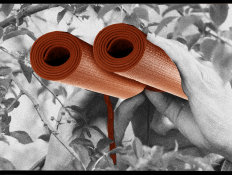María Magdalena Campos-Pons, for “Maria Magdalena Campos-Pons: Behold” at the Brooklyn Museum
September 15, 2023–January 14, 2024
Additional venues: Frist Art Museum, Nashville, Tennessee; Nasher Museum of Art at Duke University, Durham, North Carolina; J. Paul Getty Museum at the Getty Center, Los Angeles
For more than three decades, María Magdalena Campos-Pons has used her body as a vessel in performances, photographs, sculptural installations, collages, and videos. A 2023 winner of the MacArthur “genius” fellowship, the artist has variously addressed motherhood, her family’s transnational heritage, and the hidden histories all around her, using objects and sites in her home country of Cuba to speak to painful generational memories of enslavement that linger on today. Across her multifarious body of work, she shows how the past is embedded in us, the people we hold dear, and the objects we collect.
Spoken Softly with Mama (1998), an installation originally staged for the Museum of Modern Art, crystallizes many of Campos-Pons’s thematic concerns across the years. In this installation, which she made with the jazz musician Neil Leonard, Campos-Pons enlists video of herself, photographic blow-ups of her family members, ironing boards, and irons to pay homage to the long history of Black women serving as domestic workers, roles that have their precedents in slavery. She upholds that history, which has often been made invisible, and turns this space into something like an altar. The irons intentionally recall the shape of the ships used to transport enslaved Africans abroad, showing that these women are inseparable from centuries-old horrors.
That work served as an entry point for Campos-Pons’s recent retrospective. Organized by the Brooklyn Museum, the exhibition made plain how Campos-Pons’s art revels in the complexity of identity. On view were works from across decades showing how Campos-Pons has variously relied upon her Afro-Cuban heritage; her family’s Yoruba, Chinese, and Hispanic roots; her grandmother’s life as a Santería priestess; and the artist’s time spent living in Boston and, more recently, Nashville, Tennessee, where she is currently the chair of Vanderbilt University’s art department. Incorporating all these aspects of her lineage and then some, Campos-Pons presents herself as multiple, as she often does in her photographic installations composed of many prints featuring her own image.
Her recent work has incisively directed its focus toward the natural world, with her triptych Secrets of the Magnolia Tree (2021) featuring shots of trees that she came across in Nashville. Campos-Pons has painted herself among these reprinted photographs, looking upward as though she were still searching to understand what the trees had witnessed across the years.
***
Honorable Mention: Judith F. Baca, for “Painting in the River of Angels: Judy Baca and the Great Wall” at Los Angeles County Museum of Art (October 26, 2023–July 21, 2024)
Judith F. Baca’s biggest work to date, both in size and ambition, is The Great Wall of Los Angeles (1974–ongoing), a sprawling mural situated along the Tujunga Wash, a concerted area where the Los Angeles River once ran, that maps the history of both California and the United States, with women, queer people, and people of color put front and center. Overseen by the Social and Public Art Resource Center, which Baca cofounded in the 1970s, she worked with a team of at-risk youths over the course of several summers to paint the mural’s imageries which highlight historical events like the arrival of the Spanish from an Indigenous point of view and the arrival to LA of various immigrant groups to the deportation of Mexican Americans and the internment of Japanese Americans. It is located far beyond the walls of any institution.
Between 2023 and 2024, LACMA temporarily became something like a studio to Baca and her collaborators, who continued painting new portions of The Great Wall within the galleries for all to see. (The Mellon Foundation recently gave SPARC $5 million to extend The Great Wall’s imagery into the present and to converse the existing panels.) A painting of the 1961 Freedom Riders was produced here. The exhibition offered proof that Baca had helped create a crucial component of LA’s visual culture, even when mainstream institutions have been slow to offer support to achieve her artistic vision. This exhibition is one step forward in acknowledging her impact on art history.
Read more about the ARTnews Awards.

Vera Wang’s New High Jewelry Offers Black Tie Options Both Men and Women

Jill Biden’s Daughter Ashley Biden Shines in Alice + Olivia Coat With French First Lady Brigitte Macron at Notre Dame Cathedral Reopening Ceremony

Must-see TV: The 10 shows dominating the small screen right now

Red Bulls’ Unlikely MLS Cup Run Boosts Business Into 2025


